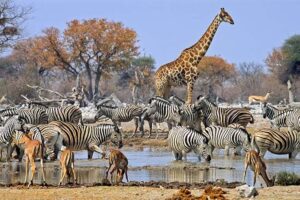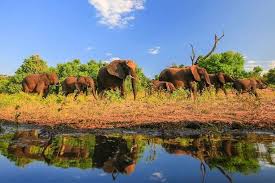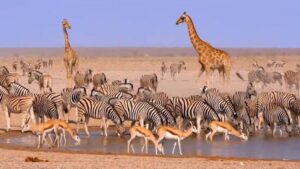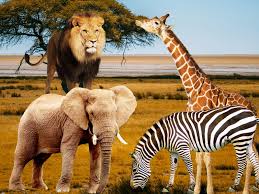Some wild African animals, such as elephants and rhinos, have ancient origins dating back to the Oligocene era, around 30 million years ago. These early ancestors of modern-day elephants and rhinos were much smaller and lived in forests rather than savannas.
African wildlife can be traced back to the Miocene era, around 20 million years ago, when the continent was home to a diverse range of animals, including early primates, giant pigs, and massive hyenas.
As the climate changed and the continent shifted, various animals evolved to adapt to different environments. For example, the giraffe evolved its long neck to reach the leaves of tall trees, while the cheetah developed its speed to chase down prey on the open grasslands.
Over time, human activities such as hunting and habitat destruction have had a significant impact on African wildlife populations. Some species, such as the black rhinoceros and African elephant, are now threatened or endangered due to these human activities.
Despite these challenges, many efforts are being made to protect and conserve African wildlife, including the establishment of national parks and conservation areas, anti-poaching measures, and initiatives to promote sustainable tourism.
Read Also: 6 Mistakes to Avoid when using Tarpaulin Fish Ponds for Profitable Fish Farming
There are many wild African animals that are unique to the continent and can be found across its diverse ecosystems. Below are a few examples:

African Elephant: The African elephant is the largest land animal on earth, with males weighing up to 14,000 pounds. They are found throughout the African continent and are known for their distinctive, long tusks.
Lion: The lion is one of the most iconic African animals and is often referred to as the “king of the jungle.” They are apex predators and can be found in grasslands, savannas, and even some forested areas.
Giraffe: The giraffe is the tallest mammal on earth, with males reaching up to 18 feet in height. They are known for their long necks, which they use to reach high branches for food.
Cheetah: The cheetah is the fastest land animal on earth, capable of running up to 70 miles per hour. They are found in grasslands and savannas across Africa.
Hippopotamus: The hippopotamus is a large, semi-aquatic animal found throughout sub-Saharan Africa. Despite their somewhat comical appearance, they are considered one of the most dangerous animals in Africa.
Rhino: There are two species of rhino found in Africa: the white rhinoceros and the black rhinoceros. Both are threatened by habitat loss and poaching.
Zebra: Zebras are known for their distinctive black and white stripes, which help to confuse predators. They are found in grasslands and savannas throughout Africa.
Gorilla: While most gorillas are found in central Africa, there are also small populations of gorillas found in some parts of East Africa. They are one of the closest living relatives to humans.
These are just a few examples of the many wild African animals that call the continent home.
Habitats and Range of Wild African Animals

The habitat and range of wild African animals are incredibly diverse due to the continent’s varied geography and ecosystems.
Here are some examples of the different habitats and ranges of African animals:
Savannas: The savanna is a grassy plain that covers a large portion of Africa and is home to many iconic African animals, including lions, cheetahs, giraffes, zebras, and wildebeests. The savanna is characterized by its vast grasslands, scattered trees, and seasonal rainfall.
Rainforests: The tropical rainforests of Central and West Africa are home to a wide variety of animals, including gorillas, chimpanzees, okapis, and forest elephants. These forests are characterized by their dense canopies, high humidity, and high levels of rainfall.
Deserts: The Sahara Desert in North Africa is the largest hot desert in the world and is home to a number of unique animal species adapted to the harsh desert environment. These include the fennec fox, dromedary camel, and sand cat.
Mountains: Many of Africa’s mountain ranges are home to unique animal species, such as the mountain gorillas of the Virunga Mountains, the gelada baboons of the Ethiopian Highlands, and the klipspringer antelopes of the Drakensberg Mountains in South Africa.
Wetlands: The wetlands of Africa are home to many species of birds, amphibians, and reptiles, as well as mammals like hippos and crocodiles. The Okavango Delta in Botswana is one of the most famous wetland ecosystems in Africa, home to a wide variety of wildlife.
Coastlines: The coastlines of Africa are home to many marine animals, such as dolphins, sharks, and sea turtles, as well as coastal birds like the African penguin. The coral reefs along the coastlines of East Africa are also home to a variety of marine species.
These are just a few examples of the different habitats and ranges of wild African animals. Africa’s rich and diverse geography has given rise to an equally rich and diverse array of wildlife, making it a truly unique and special continent.
Read Also: Wild Life Zoo: Meaning and Economic Importance
Behavioral Adaptation of Wild African Animals

Wild African animals have evolved various behavioral adaptations to survive and thrive in their environments. Here are a few examples:
Migration: Many large mammals such as wildebeest, zebras, and gazelles undertake long-distance migrations in search of food and water. They follow the seasonal rains and move to areas with abundant vegetation. This behavior allows them to access resources that would not be available if they remained in one location.
Nocturnal behavior: Some animals, such as lions and leopards, are nocturnal, meaning they are active at night. This allows them to avoid the heat of the day and to hunt when their prey is most active.
Social behavior: Many animals, such as elephants and primates, live in social groups. This behavior provides protection against predators and allows for cooperative hunting and foraging.
Camouflage: Animals such as cheetahs and leopards have evolved camouflage that helps them blend into their surroundings, making them less visible to both prey and predators.
Adaptation to water scarcity: Desert-adapted animals, such as the oryx and the camel, have evolved adaptations that allow them to survive in extremely arid environments. They are able to conserve water and reduce their need for it through various physiological and behavioral adaptations.
Overall, wild African animals have evolved a diverse range of behavioral adaptations that allow them to survive and thrive in their environments. These behaviors have helped them to become some of the most fascinating and iconic animals on the planet.
Read Also: 15 Amazing Benefits of Drinking Water Always
Frequently Asked Questions
We will update this section soon.

